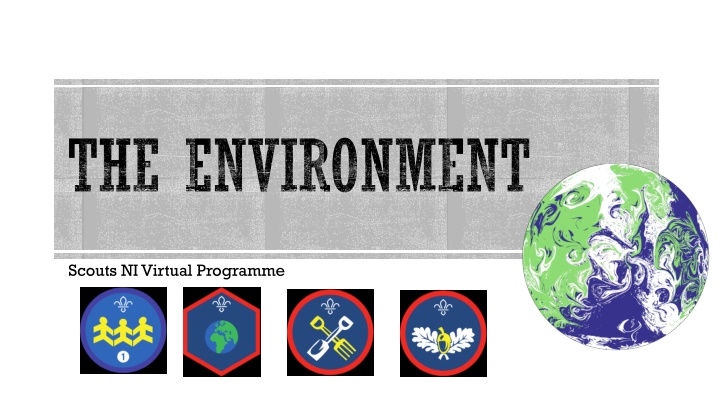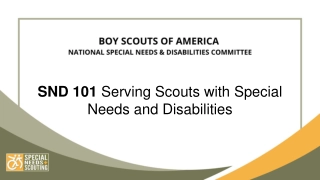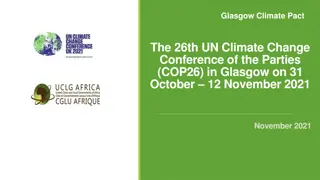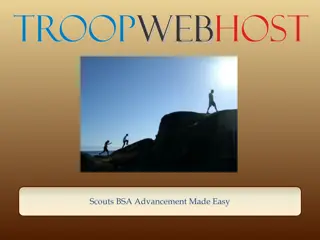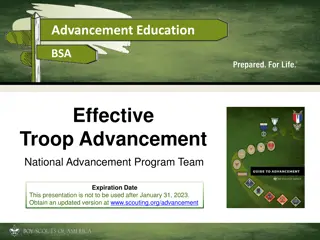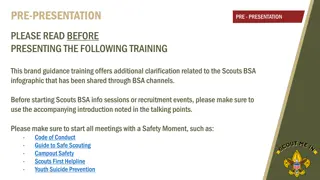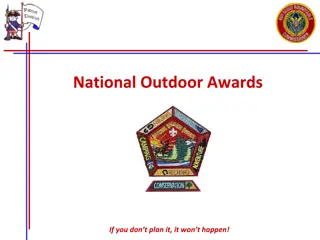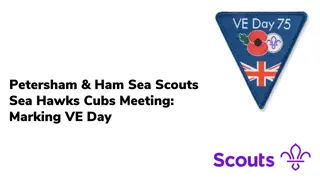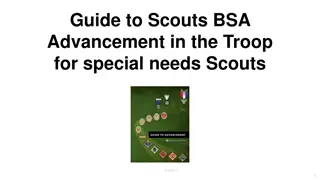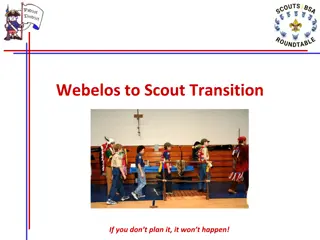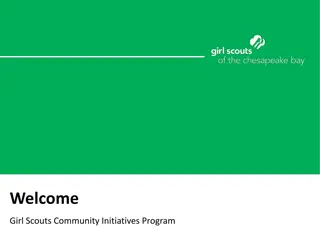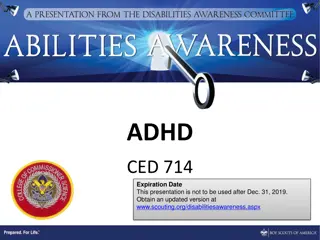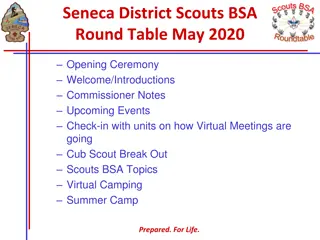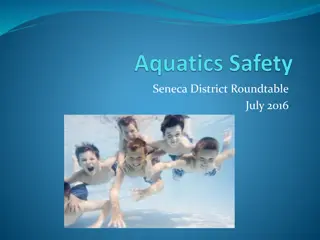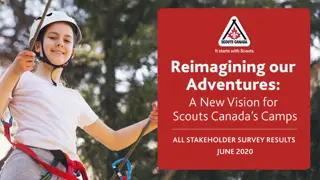The Environment Scouts NI Virtual Programme and COP26: Taking Action for a Sustainable Future
Discover the alarming facts about our impact on the environment and the urgent need for action. Learn how to reduce waste, travel responsibly, and support sustainability. Explore the upcoming COP26 summit in Glasgow and the vital role of bees in our ecosystem. Join Scouts UK in playing a part in preserving our planet for future generations.
Download Presentation

Please find below an Image/Link to download the presentation.
The content on the website is provided AS IS for your information and personal use only. It may not be sold, licensed, or shared on other websites without obtaining consent from the author.If you encounter any issues during the download, it is possible that the publisher has removed the file from their server.
You are allowed to download the files provided on this website for personal or commercial use, subject to the condition that they are used lawfully. All files are the property of their respective owners.
The content on the website is provided AS IS for your information and personal use only. It may not be sold, licensed, or shared on other websites without obtaining consent from the author.
E N D
Presentation Transcript
THE ENVIRONMENT Scouts NI Virtual Programme
Did you know .. If Earth s history is compared to a calendar year: Modern human has existed for about 37 minutes. One third of Earth s natural resources has been consumed in the last 0.2 seconds (by modern humans). Human consumption of Earth's natural resources more than tripled between 1970 and 2015. Our use of natural resources is expected to continue growing and more than double from 2015 to 2050. If current patterns continue, we will have emptied the world s oceans for seafood by 2050. Rainforests are cut down at a rate of 100 acres per minute. The world population is 215,000 people larger today than it was yesterday. Landfills are composed of 35% packaging materials A glass bottle made in our time will take more than 4,000 years to decompose
Use your voice. We are the first generation to know we're destroying the world, and we could be the last that can do anything about it. ... Be political. Be Informed. These Facts are truly terrifying, but what can we do? It will effect everyone and everything on our planet and in our daily lives, regardless of race, gender, creed or wealth. Reduce your waste Watch what you buy. Travel responsibly. Eat sustainably. Find ways to donate.
What's happening this year? In Glasgow!!!!
But what is it? COP refers to the decision-making body of the United Nations Framework Convention on Climate Change (UNFCCC). In November 2021, the UK will be hosting the 26th annual session of the Conference of the Parties to the Convention, or COP26 , in Glasgow. At the summit, delegates including heads of state, climate experts and negotiators will come together to agree coordinated action to tackle climate change. As well as the negotiations, there will also be space for countries, international organisations and other delegates to showcase climate action, highlight diverse climate change issues and share knowledge. Scouts UK will be part of this Summit.
WE CAN ALL PLAY A PART This week we are going to look at the importance of Bees in our environment, how they are vital for our food supply and how we can enhance our world by helping our buzzy friends thrive.
Lets talk about Bees. The greatest contribution of bees and other pollinators is the pollination of nearly three quarters of the plants that produce 90% of the world's food. A third of the world's food production depends on bees, i.e. every third spoonful of food depends on pollination. Ending hunger is everyone's responsibility. As pollinators, bees play a part in every aspect of the ecosystem. They support the growth of trees, flowers, and other plants, which serve as food and shelter for creatures large and small. Bees contribute to complex, interconnected ecosystems that allow a diverse number of different species to co-exist. Bees are needed to ensure the survival of ecosystems across the globe and sustaining food production for humans.
How can we help the Bee population Help to protect swarms Swarming is a natural process when colonies of honeybees can increase their numbers. If you see a swarm contact the local authority or the police who will contact a local beekeeper who will collect the swarm and take it away. Set up a bee garden right away. Plant more Bee friendly flowers rich in Pollen and Nectar. Plant through the seasons to provide year-round bee habitat. Create a safe place for Bees such as a Bee house or Hotel Save the bees and put away the pesticides Bee friendly When kept properly, bees are good neighbours, and only sting when provoked. Beekeepers wear protective clothing when they are handling bees. If a bee hovers inquiringly in front of you when unprotected, do not flap your hands. Stay calm and move slowly away, best into the shade of shed or a tree. The bee will soon lose interest
Now for a Bee friendly project Building a BEE house Making a Bee Bomb
BUILDING A BEE HOUSE Why build a bee hotel? Our bees are facing an unprecedented crisis. They ve lost much of their natural habitat in the past 60 years including 97% of wildflower- rich meadows. They're under assault from pesticides, intensive farming and climate change. By creating bee-friendly spaces where we live, we can start to replace and restore some of this lost habitat and help Britain bloom for bees. This link will show you how to make a simple Bee House/hotel How to build a bee house - YouTube
What you will need Hollow sticks and small sticks. Bamboo is perfect although you may have to cut them down to size. All you sticks need to be as close in size as possible. A clean hollow container, preferably a tin can or plastic bottle You might need to use Pruning Shears for this Garden Twine Pruning Shears Scissors
What to do next: If you are using a plastic bottle, cut off the top of your bottle so that it looks a little bit like a pencil holder. (If you are using a can make sure it is clean with no sharp edges Cut your sticks and bamboo to size. They should be the same height as the container you are using and fill your container until full. Using your garden twine or string wrap it around the container like a coiled rope to disguise the can or bottle and make the container look more nature like. Using two lengths of garden twine or string tie one piece at the bottom of the container and another piece at the top to hang your bee hotel safely above the ground
If you fancy doing a bigger scout project? This might be one for your Troop ..
What are Bee bombs? Bee bombs are handmade wildflower seed balls. We make them from sheltering clay and sifted top soil, packed with 1000s of seeds from native wildflower species. Bee bombs need no gardening skill and can be scattered straight onto open ground at any time of the year MAKING A BEE BOMB Creating your seed bomb: 1. In a bowl, mix together 1 cup of seeds with 5 cups of compost and 2-3 cups of clay powder (you could use clay soil instead if you have it). 2. Slowly mix in water with your hands until everything sticks together. 3. Roll the mixture into firm balls. 4. Leave the balls to dry in a sunny spot. 5. Now for the fun bit, find some clear ground and throw or catapult until the seed bomb breaks up, and leave for beautiful bee friendly flowers to grow
TRUE OR FALSE Can you tell what's true or false about these Bee Statements? Thumbs up for TRUE and Thumbs Down for FALSE
Honey Bees communicate with each other through a special Dance called the Waggle Dance . This tells the Bees the distance an direction to the nearest flowers, the bigger the waggle the bigger the food! TRUE
A single Hive contains about 10,000 Bees? False A single Hive usually contains between 40000-45,000 Bee s
Bees live in colonies where there are three different types of Bee; The Queen Bee The Worker Bee and the Drone Bee True
Only the Queen Bee is Female? False The Queen and the Worker Bees are Female
Bees are responsible for one in every three bites you eat because of their pollination of crops and flowers True Bee s are important for human survival
Crystallised Honey means its gone off False Honey is one of the few food products that does not have a shelf life
All Bees can sting False Only female Bee can sting as the stinger is modified egg laying device, so male Bees cannot sting
All Bees produce honey False Less than 5 percent of bee species make honey. (There are over 20,000 bee species) Only honey bees and stingless bees produce enough honey to make it worth harvesting. Bumble bee hives may have a small amount (one to two teaspoons). Bumble bees are annual, not perennial, so they don t need to produce a lot of honey to survive the winter
Bees have short life spans True Solitary bees live only a few weeks just long enough to mate, build nests and produce offspring. Honey and bumble bee workers and males live about six weeks. The workers spend half their time working on the hive and the other half foraging for pollen and nectar. The queens live longer. Bumble bee queens live up to one year, and honey bee queens can live up to four years
Dont forget that you can make a difference. Bee Happy and we ll see you soon
